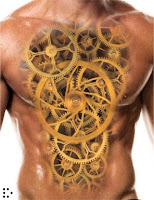The other morning, I burnt my eggs. I put six jumbos on to
boil, anticipating the delight of an egg salad sandwich, but forgot to set the
timer before sitting down to write. Forty minutes later, my concentration was
broken by a loud popping sound emanating from the kitchen. I rushed to the
stove as, one by one, my eggs exploded.
As I scraped the pot, I got to thinking about timing.Timing was a major theme in my previous occupation. The job of a firefighter/paramedic
Now that I’m an archaeologist, timing takes on different dimensions. I no longer deal in minutes; my research spans centuries and millennia. Thus, it was a shock to my system transitioning from the heart-pounding, adrenaline-pumping pace of emergency medicine to the tedious, methodical approach of archaeology.
As a firefighter, I experienced the joy of destruction. It’s critical to open up confined spaces to search out hidden flames, so at every fire, we would blissfully tear out walls and pull ceilings. God, it was fun.
 Archaeology, on the other hand, requires painstaking
excavation, the meticulous exposure of a site’s history. My archaeological field school was an excruciating trial in patience. I imagined driving my fist through those perfect walls, taking a sledge to
those stubborn soils. It’s probably best I stick to the lab.
Archaeology, on the other hand, requires painstaking
excavation, the meticulous exposure of a site’s history. My archaeological field school was an excruciating trial in patience. I imagined driving my fist through those perfect walls, taking a sledge to
those stubborn soils. It’s probably best I stick to the lab.But it turns out timing is critical to my work as a bioarchaeologist, for the analysis of human remains is based on timing. Here’s how:
For every skeleton that comes out of the ground, a basic assessment is conducted. This is the information that provides the fundamentals of bioarchaeological research. It all begins with sex (as everything should).
The sex of the individual is determined based on the size and shape of bones, as well as certain landmarks on the skeleton. This is where timing comes in, for only after puberty do our skeletons develop the characteristic traits that distinguish male from female. The skull and pelvis morph with sexual maturity, making it fairly simple to identify the sex. Unfortunately, we lack a definitive means of sexing children, unless we’re lucky enough to obtain DNA.
Determining the age at death is also based on timing. For children, the eruption of teeth provides a wonderful tool, since we know, on average, when each tooth emerges in the mouth. For adults, we use certain surfaces on the skeleton, primarily the pelvis, because these surfaces change as we age.
Height is determined by measuring the long bones of the body, primarily the femur. The length of the bone is put into a regression formula, which reveals the overall height of the body. But once again, timing plays a role. Growth in children depends on the quality of their diet, their exposure to disease, and, of course, genetics. But even if a child’s growth is challenged, science has shown that children can experience “catch-up growth” in their teens, should conditions improve.
So why do we care about the sex, age, and height of individuals long dead? Because this information provides the tools with which we reconstruct past lives.
For example, let’s say we excavate a cemetery of one hundred well-preserved skeletons (every bioarchaeologist’s dream). If we know the sex of the individuals, we can deduce aspects of their social structure. If the majority of the skeletons are male, perhaps they were engaged in intensive warfare. An abundance of females may indicate differential access to high quality foods.
 Height also provides information about overall health, for
you’re not going to grow big and strong if you’re undernourished and plagued
by pathogens.
Height also provides information about overall health, for
you’re not going to grow big and strong if you’re undernourished and plagued
by pathogens.So even though I no longer treat patients or fight fires, timing is still fundamental to my existence. As the skeleton grows and matures, it changes, and it’s these changes that provide the building blocks of bioarchaeological research by allowing us to tease information from the fragile remains of those who lived thousands of years in the past. Amazing!
What I consider the bible of bioarchaeology: an oldy but a goody.





